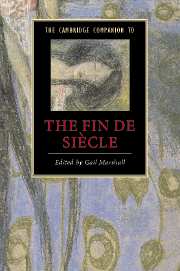Book contents
- Frontmatter
- Introduction
- 1 Psychology at the fin de siècle
- 2 Decadence and aestheticism
- 3 Sexual identity at the fin de siècle
- 4 Socialism and radicalism
- 5 Empire
- 6 Publishing industries and practices
- 7 The visual arts
- 8 The New Woman and feminist fictions
- 9 Realism
- 10 The fantastic fiction of the fin de siècle
- 11 Varieties of performance at the turn of the century
- 12 Poetry
- Guide to further reading
- Index
- Series List
10 - The fantastic fiction of the fin de siècle
Published online by Cambridge University Press: 28 September 2008
- Frontmatter
- Introduction
- 1 Psychology at the fin de siècle
- 2 Decadence and aestheticism
- 3 Sexual identity at the fin de siècle
- 4 Socialism and radicalism
- 5 Empire
- 6 Publishing industries and practices
- 7 The visual arts
- 8 The New Woman and feminist fictions
- 9 Realism
- 10 The fantastic fiction of the fin de siècle
- 11 Varieties of performance at the turn of the century
- 12 Poetry
- Guide to further reading
- Index
- Series List
Summary
Did any period in literary history produce a higher concentration of masterpieces of fantastic fiction than the Victorian fin de siècle? Within a single three-year period appeared H. G. Wells's The Time Machine (1895), Bram Stoker's Dracula (1897), and Henry James's The Turn of the Scre (1898). And these were just the most prominent peaks of a Himalayan range of fantastic fiction rising abruptly at the end of the nineteenth century. But before trying to account for this phenomenon, I should explain what I mean by fantastic fiction. Many of the generic labels used to classify popular fiction today were not yet in use in the nineteenth century. 'Science fiction', for example, did not exist in 1895 when H. G. Wells embarked on a series of novels that are now considered classics of the genre. It was not until the 1930s that the phrase began to be used to describe a number of works of fiction that seemed to share a family resemblance. The 'fantasy' and 'horror' sections of bookshops today carry labels recently developed by the publishing industry to exploit the popularity of J. R. R. Tolkien and Stephen King, respectively. Popular genres are fluid entities, forming, blending and dissolving in response to changes in the literary marketplace. Here I will argue that one of the great literary achievements of the fin de siècle was a successful break with fictional realism, and so I require a transgeneric category embracing all the works that I will offer as evidence. In the fin de siècle itself, a novel was a realistic work; contemporary critics noted a revival of romance, namely fiction containing magical, supernatural and other non-realistic elements.
- Type
- Chapter
- Information
- The Cambridge Companion to the Fin de Siècle , pp. 189 - 206Publisher: Cambridge University PressPrint publication year: 2007
- 4
- Cited by

